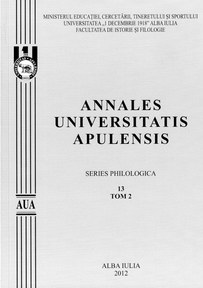Semiadverbul – clasă eterogenă. Aspecte din limba română contemporană
The Semi-Adverb-an Eterogenous class. Aspects of the Contemporary Romanian Language
Author(s): Silvia Andreia PinteaSubject(s): Language and Literature Studies
Published by: Universitatea »1 Decembrie 1918« Alba Iulia
Keywords: semi-adverb; heterogeneous character; deficiency; clitic; morpheme; particle/unit
Summary/Abstract: The present article aims to analyze the Romanian semi-adverb in the context of the contemporary Romanian language. Throughout the analysis, I tried to highlight the main aspects of the semi-adverb such as: 1. The concept of semi-adverb. Definition. Terminology. 2. Semantic categories of semi-adverbs. 3. Semi-adverbs from a semantic-functional perspective. 4. Synonyms, antonyms, homonyms – semantic and formal relations of semi-adverbs. 5. The semi-adverb’s role in French, Italian, Spanish, Portuguese. 6. The semi-adverb seen in relation with the deficiency theory. Known as semi-adverbs, these units have a variety of interpretations and are the starting point for many approaches – lexical, semantic, morphologic, syntactic, and pragmatic. The category of semi-adverbs is quite controversial and very heterogeneous due to the variety of combinations available. The ambiguous nature and the abstract semantics of semi-adverbs leads to a difficulty in shaping a type of taxonomy that would fully satisfy all the constituent elements (approximately 70). The main impediments are, on the one hand, that these units may - according to the different meanings they can take – belong to two or three semantic subclasses, while on the other hand there are various points at issue regarding the semantic classification of adverbs in general. Therefore, while expressing a variety of shades of meaning, we suggest a classification that may facilitate an approach to this category which is far from being a complete classification. The comparative analysis carried out with the main Romanic languages (French, Italian, Spanish, and Portuguese) aims to be a means to show the current differences and resemblances between them, as well as a means to shed light on the importance of this category. Recent research in linguistics has produced a new theory that approaches all the categories of words - the deficiency theory (fr. déficience, faiblesse). Semi-adverbs have proved to be extremely compatible with this theory due to their heterogeneous character. This theory has many variants. The one we have chosen is the one detailed by A. Abeillé şi D. Godard, in their study Grammaire Typologique des Formes Faibles. To sum up, we can talk about deficiency when a unit does not have all the properties necessary to function in an autonomous way in a certain field of grammar. Thus, a unit may have deficiency at the phonological, morphological, syntactical or semantic level. In order to underline the aspects of the language analyzed, I have chosen as material basis Ion Manolescu’s novel “Derapaj” (”Sideslip”) and in order to highlight the differences between Romanian and other Romanic Languages, I picked the most important examples from the grammar books I have taken into consideration for this study.
Journal: Annales Universitatis Apulensis. Series Philologica
- Issue Year: 13/2012
- Issue No: 4
- Page Range: 295-318
- Page Count: 24
- Language: Romanian

